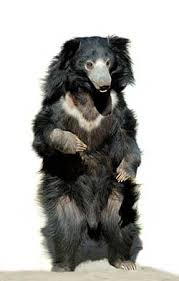Time to learn about another bear, this week we have the sloth bear,
also known as the Indian bear, is a myrmecophagous bear species native to the
Indian subcontinent. It feeds on fruits, ants and termites. It is listed as
vulnerable on the IUCN Red List, mainly because of habitat loss and
degradation. It is the only species in the genus Melursus.
Sloth bears have shaggy, dusty-black coats; pale, short-haired
muzzles; and long, curved claws which they use to excavate termites and
ants. A cream-colored “V” or “Y” shape usually marks their chests. Their shaggy
fur does not have an undercoat, so it keeps them relatively cool in their
native, warm climate and protects them from tropical insects. Sloth bears'
nostrils can close completely, protecting the animals from dust or insects when
raiding termite nests or beehives. They have a keen sense of smell, as well as
near-sight similar to that of humans.
Adult sloth bears are missing their top two front teeth (incisors), which enables them to suck up termites and other insects with ease. Due to their diet of insects and fruit, their premolars and molars are smaller than those of other bears, but they have large canines to use for defence. It is thought that their feet are turned inward to increase digging efficiency.
They grow 5 to 6 feet (1.5 to 2 meters) long, stand 2 to 3 feet
(0.5 to 1 meters) high at the shoulder, and weigh, on average, 200 to 300
pounds (90 to 140 kilograms).
They live in a variety of dry and moist forests and in some tall grasslands, where boulders, scattered shrubs and trees provide shelter. Their range includes India, Sri Lanka and southern Nepal.
They are noisy, busy animals. They grunt and snort as they pull
down branches to get fruit, dig for termites and ants, or snuffle under debris
for grubs and beetles.
If threatened, they will stand on two legs, brandishing their
clawed forepaws as weapons. Their large canines are used for defence against
tigers. Other potential predators include jackals, wild dogs, wolves, leopards
and other Asian bear species.
They are considered myrmecophagous. They feed on termites, ants,
also when trees are in fruit, usually during the monsoon season, sloth bears
dine on mango, fig, ebony and other fruits, as well as on flowers.
Termites, dug out of their cement-hard nest mounds, and some
ants are year-round staples. During non-fruiting season, insects
constitute 95 percent of a sloth bear's diet. Sloth bears climb trees and
knock down honeycombs, later collecting the honey from the forest floor.
Beetles, grubs and other insects round out their diet. During food
shortages, sloth bears will eat carrion. They also sometimes raid farm crops.
These bears adapt their sleep-wake cycle to their environment
and may be on a nocturnal, diurnal or crepuscular schedule depending on how
many other bears, people or predators share their habitat. In protected
areas, for example, sloth bears may be more active during the day. Sloth
bears are typically active for about eight to 14 hours each day, and they do
not hibernate. At the Zoo, they tend to keep a crepuscular schedule, meaning
they are active in both the morning and evening but sleep midday and overnight.
Theys are considered solitary, although they are occasionally
seen in groups when resources are plentiful.
They only come together during breeding season. The female uses
delayed implantation to decide the best time for her pregnancy and birthing.
The female will then remain in a den for 6-7 months until she gives birth. The
most common number of cubs is 2. After the mother and cubs leave the den, the
cubs will ride on the mother’s back and cling to her long fur. No other bear
species does this. As they grow, the cubs will begin to walk on the ground. The
female nurses the cubs for one year and they will stay with mom for up to 2.5
years.
While not typically aggressive towards humans, can exhibit
defensive aggression when surprised or feeling threatened, leading to
attacks. These attacks are usually a result of the bear's defence
mechanism and not predatory behaviour. Sloth bears are often involved in
human-wildlife conflict due to habitat encroachment and encounters in
agricultural areas.







Interesting about these bears, Jo-Anne. Thank you.
ReplyDeleteThank you I thought so
DeleteWell that's one I've never heard of before.
ReplyDeleteIt was new to me also
DeleteAnother new one on me, Jo-Anne. What fascinating bears these are, for sure. Blessings!
ReplyDeleteThey are indeed fascinating
DeleteI had seen pictures but knew nothing about these bears. That they love ants and other bugs and are that large was amazing to me. And the babies ride on their backs! So interesting! Thanks. :)
ReplyDeleteYes when I read about the babies riding on their backs I thought of Koloas which do the same
DeleteI'd never heard of this particular bear. They aren't found in the US so maybe that's why. I hope you're doing well!
ReplyDeleteYes maybe that is why they are also not found here but they are interesting, yes I am doing on although the cold weather is giving me headaches
DeleteSomething else I knew little about.
ReplyDeleteCome here and discover stuff
DeleteI don't think I've ever heard of them before. I'm surprised at what they feed on. Thanks for sharing.
ReplyDeleteYeah I never thought of bears eating ants and insects
Delete